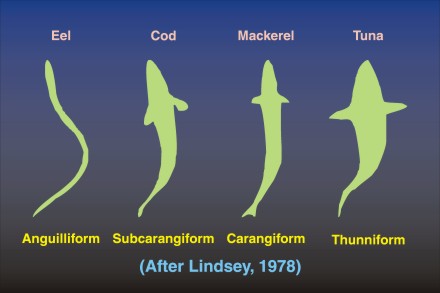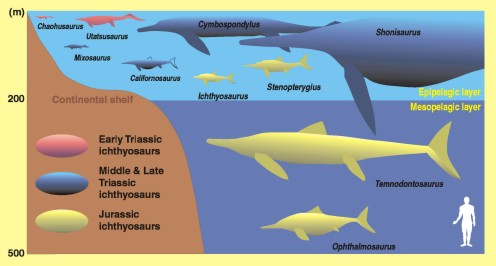Ichthyosaur Swimming
Ichthyosaur Swimming
a mirror of some the content of Ryosuke Motani's excellent webpage on Ichthyosaurs
in memory of Australia's Ichthyosaur hunter Mary Wade 1928-2005
5. SWIMMING EVOLUTION IN ICHTHYOSAURS
As I pointed out in Introduction,
early ichthyosaurs were lizard-shaped, and fish-shaped ichthyosaurs then
evolved from among them. Unsurprisingly, the way ichthyosaurs swam also
changed with the body shape evolution.
Many living fish undulate or oscillate their body axes for swimming.
They are usually categorized into four swimming types, depending on how
much of the body stays more or less stable (figure below). Anguilliform,
or eel-like swimmers undulate their entire body, whereas thunniform, or
tuna-like swimmers move only the posterior part of their body, keeping
the anterior part steady.

Lizard-shaped ichthyosaurs shared some characteristics of living
catsharks (see the section on Vertebrae):
they
have slender trunk, slender backbone, and high numbers of vertebrae.
Catsharks are eel-like swimmers, so it is likely that lizard-shaped
ichthyosaurs were eel-like swimmers too. This is not surprising since
many lizards today swim in eel-like manners when in water.
Fish-shaped ichthyosaurs, on the other hand, resembled mackerel sharks, such as the Great White, with thick body trunks and thick backbone, as well as crescent-shaped tails. These characteristics suggest that many fish-shaped ichthyosaurs were tuna-like swimmers. I can tell you more about this in the future.
Eel-like swimming provides good combination of maneuverability and acceleration, and is sufficient for those vertebrates living in the area of continental shelf. Tuna-like swimming is known in cruising vertebrates that invade open oceans, and provides energy-efficient swimming at a steady speed. So, it looks like life styles changed drastically between lizard-shaped and fish-shaped ichthyosaurs, from dwellers of continental shelf to cruisers of the ocean.

.
see also... ICHTHYOSAURS
INTRODUCTION
FOREFIN
EYES
VERTEBRAE SIZE
DIETS
SWIMMING DIVING
PHYLOGENY MARY WADE
LITERATURE
COPYRIGHTS back to
Earth Science Australia...

